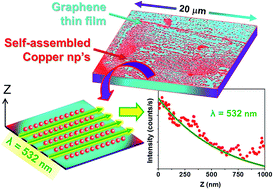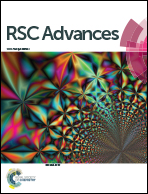Self-assembled metallic nanoparticle superlattices on large-area graphene thin films: growth and evanescent waveguiding properties†
Abstract
We report a facile fabrication method for copper nanoparticle superlattices, based on thermal evaporation of ultrathin layers of copper on solution-processed thin films formed by few-layer graphene platelets. We show that the annealing of these systems in nitrogen without previous exposure to air prompts the heterogeneous nucleation of the Cu layer into nanoparticle superlattices self-assembled along specific crystallographic directions of graphene. Theoretical calculations suggest a lowest formation energy for Cu-nanoparticle arrays aligning along armchair directions, indicating that their self-assembly is energetically more favourable. The possibility of using these superlattices in evanescent waveguiding devices is explored by three-dimensional scanning near-field optical microscopy. The light-confining properties of our systems in the near-field indicate that our nanoparticle superlattices are poised to satisfy the technological demands required by nanophotonics devices.


 Please wait while we load your content...
Please wait while we load your content...